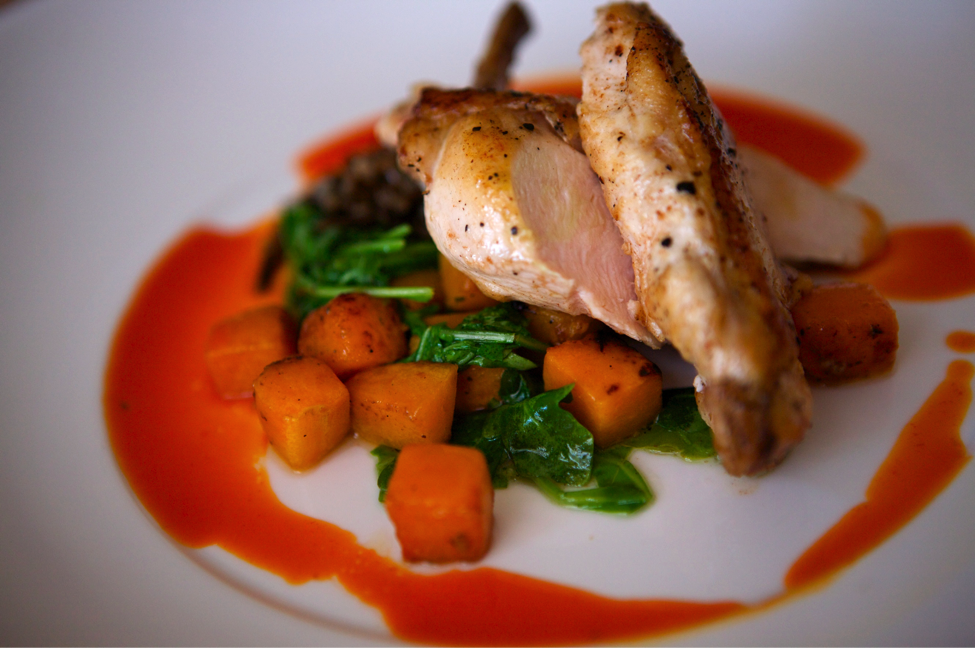
#MeetUsIntheKitchen – Squash: Fall’s Boundless Ingredient
Culinary Culture
Recipes
Once the smell of fall is officially in the air and we’ve pulled our jackets from their hibernation, our minds turn to fall’s ubiquitous and versatile ingredient: squash. It’s an old friend we are always happy to see here at Blue Plate as its subtle sweetness, mild nuttiness and vibrant colors provide us with a sandbox of inspiration to explore.
Types of Squash
While available all year long, (think zucchini or the fun, miniature, pattypan squash), winter squash takes longer to mature and is best harvested once cooler weather sets in. They are typically elongated and pear-shaped, and the most common types include butternut, acorn, banana, delicata, spaghetti squash, kabocha and even pumpkin.
Kabocha squash have a remarkably sweet and tender flesh with a slightly nutty flavor. The dense, smooth, sweet flesh is so tasty that it needs very little fuss in preparation. Roasting or slicing and baking it with a bit of butter or oil and salt are the only ingredients this delicious squash needs. The dense flesh also holds its shape when cooked, even in liquids, which makes it perfect for using as chunks in soups or steamed dishes.


Preparation and Storage
If you’ve ever taken a knife to a winter squash you know the task can be daunting; their heartiness doesn’t betray. To protect yourself, we recommend shaving a flat surface on the bottom so the squash doesn’t wobble when cutting. Alternatively, for thinner skinned squash, we suggest using a vegetable peeler to remove the skin. One favorite technique is to shave and julienne the squash into fine threads that can then be fried and used as a garnish on main dishes or hors d’oeuvres.
When storing, cool, dark places are squash’s best friend so avoid putting it in the refrigerator whole unless you want to cut ahead of time for prep. Squash with stems will also last longer than squash without if you are lucky to come across a large quantity of them.
Common Uses
Squash can be used in a variety of ways like the simple yet silky butternut squash soup to a filling for ravioli, or a holiday favorite, the nostalgic pumpkin pie. For our chefs, they prefer an easy preparation by oven roasting. Once the squash is cooked and tender, it can be used for many different applications. The cooked squash can be cut up and put into salads, or pureed and turned into a sauce or soup. One application that is unique and fun is using it on S’mores; the nuttiness and savory aspect works well with marshmallow, chocolate and graham crackers.
Use our recipe below for a simple oven roasted kabocha (or other winter squash) to liven up your fall creations. Then share your #MeetUsInTheKitchen inspirations and other fall dishes with us on Instagram at @blueplatechicago.
What you’ll need:
- 1 each Kabocha squash
- 2 Tbsp Butter
- 1 each Cinnamon Stick
- 1 each Orange
- 1 Sprig Fresh Sage
- 1 Tsp Salt
- ½ Tsp Pepper
Preheat oven to 350 degrees
Cooking time: Approximately 30 min
Remove the skin from the kabocha and cut into eight quarters, then place the pieces in a bowl. In a saute pan, add butter, a crushed cinnamon stick, an orange peel, and fresh sage. Heat until the butter is melted and the aromatics come together. Once the butter is melted, drizzle it into the bowl with the squash; season with salt and pepper. Place all the ingredients in a pan and cover with plastic and foil (this helps to cut down on the cooking time.) Cook for about 15 minutes, covered. Halfway through the squash cooking process, remove the pan from the oven. Once the pan is removed, turn up the oven to 450. Remove the plastic and foil and roast for an additional 15 minutes or until tender.